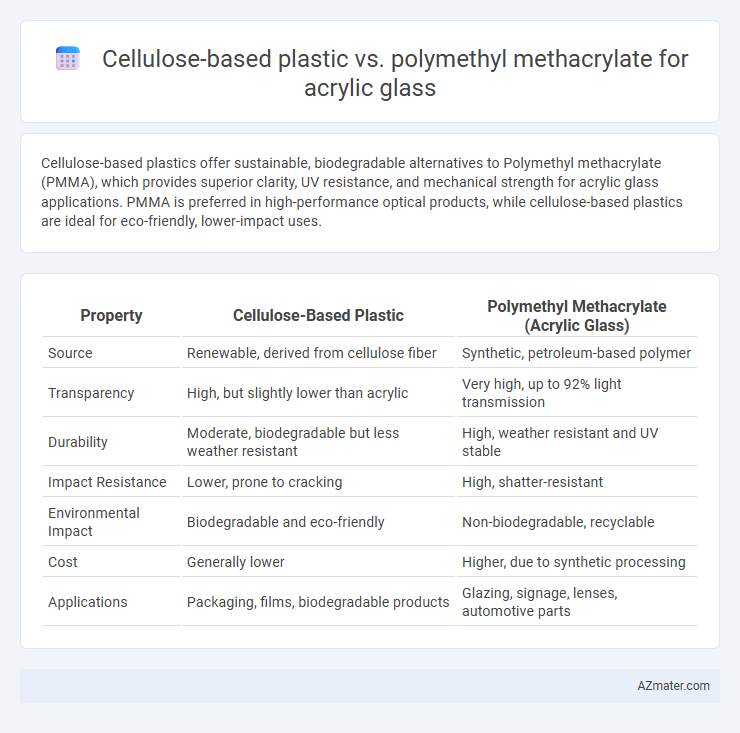Cellulose-based plastics offer sustainable, biodegradable alternatives to Polymethyl methacrylate (PMMA), which provides superior clarity, UV resistance, and mechanical strength for acrylic glass applications. PMMA is preferred in high-performance optical products, while cellulose-based plastics are ideal for eco-friendly, lower-impact uses.
Table of Comparison
| Property | Cellulose-Based Plastic | Polymethyl Methacrylate (Acrylic Glass) |
|---|---|---|
| Source | Renewable, derived from cellulose fiber | Synthetic, petroleum-based polymer |
| Transparency | High, but slightly lower than acrylic | Very high, up to 92% light transmission |
| Durability | Moderate, biodegradable but less weather resistant | High, weather resistant and UV stable |
| Impact Resistance | Lower, prone to cracking | High, shatter-resistant |
| Environmental Impact | Biodegradable and eco-friendly | Non-biodegradable, recyclable |
| Cost | Generally lower | Higher, due to synthetic processing |
| Applications | Packaging, films, biodegradable products | Glazing, signage, lenses, automotive parts |
Overview of Cellulose-Based Plastics
Cellulose-based plastics are derived from natural polymers found in plant cell walls, offering a sustainable and biodegradable alternative to traditional plastics such as polymethyl methacrylate (PMMA) used for acrylic glass. These plastics exhibit high transparency, good mechanical strength, and lower environmental impact due to their renewable origin and biodegradability. While PMMA provides superior clarity and weather resistance, cellulose-based plastics are gaining attention for eco-friendly applications where sustainability is a priority.
Introduction to Polymethyl Methacrylate (PMMA)
Polymethyl methacrylate (PMMA) is a synthetic polymer widely used as a lightweight, shatter-resistant alternative to traditional glass. Its clarity, UV resistance, and excellent weatherability make PMMA an ideal material for acrylic glass applications in automotive, construction, and display industries. Compared to cellulose-based plastics, PMMA offers superior optical properties and durability, enabling its extensive use in high-performance transparent panels and lenses.
Material Origin and Sustainability
Cellulose-based plastic derives from renewable plant fibers, offering a biodegradable and environmentally friendly alternative to conventional plastics. Polymethyl methacrylate (PMMA), commonly known as acrylic glass, is a synthetic polymer produced from petroleum-based raw materials, posing challenges in terms of sustainability due to its non-biodegradable nature and reliance on fossil fuels. The use of cellulose-based plastics supports reduced carbon footprint and enhanced recyclability, whereas PMMA's durability and clarity come at the cost of limited eco-friendly disposal options.
Mechanical Strength and Durability Comparison
Cellulose-based plastics exhibit moderate mechanical strength with notable flexibility but generally lack the hardness and impact resistance found in polymethyl methacrylate (PMMA), which provides superior rigidity and tensile strength ideal for acrylic glass applications. PMMA demonstrates exceptional durability against UV radiation, weathering, and chemical exposure, extending the lifespan of acrylic glass products compared to cellulose-based plastics that degrade more rapidly under environmental stress. The enhanced toughness and resistance to cracking make PMMA the preferred choice where long-term performance and structural integrity are critical.
Optical Clarity and Light Transmission
Cellulose-based plastics exhibit moderate optical clarity with light transmission typically ranging from 80% to 90%, making them suitable for applications requiring natural and biodegradable materials. Polymethyl methacrylate (PMMA), commonly known as acrylic glass, offers superior optical clarity and exceptional light transmission of approximately 92% to 93%, closely rivaling the clarity of glass. PMMA's high transparency and resistance to yellowing make it the preferred choice for applications demanding maximum light transmission and visual clarity.
Chemical Resistance and Weathering
Cellulose-based plastics exhibit moderate chemical resistance but tend to degrade under prolonged exposure to harsh solvents, limiting their use in aggressive chemical environments. Polymethyl methacrylate (PMMA), commonly known as acrylic glass, shows superior resistance to UV radiation and weathering, maintaining clarity and mechanical strength over long-term outdoor exposure. PMMA's enhanced weathering resistance and stable chemical profile make it preferable for applications demanding durability against environmental stress and chemical exposure.
Environmental Impact and Biodegradability
Cellulose-based plastics offer superior environmental benefits over polymethyl methacrylate (PMMA) for acrylic glass due to their renewable sourcing and enhanced biodegradability, breaking down naturally within months under composting conditions. In contrast, PMMA, derived from petrochemicals, exhibits high durability but persists in the environment for decades, contributing to plastic pollution and microplastic formation. Life cycle assessments highlight cellulose plastics' lower carbon footprint and reduced ecological toxicity compared to PMMA, making them a more sustainable choice for transparent materials.
Applications in Acrylic Glass Production
Cellulose-based plastics offer eco-friendly alternatives in acrylic glass production, primarily used for sustainable, biodegradable panels and displays where environmental impact is critical. Polymethyl methacrylate (PMMA) dominates the market due to superior optical clarity, weather resistance, and mechanical strength, making it ideal for high-quality lenses, signage, and transparent protective barriers. Both materials serve distinct roles, with cellulose-based plastics driving green innovation and PMMA ensuring performance and durability in acrylic glass applications.
Cost-Effectiveness and Market Availability
Cellulose-based plastics offer a more cost-effective alternative to polymethyl methacrylate (PMMA) for acrylic glass due to lower raw material expenses and biodegradability, reducing long-term environmental costs. PMMA dominates the market with widespread availability and superior clarity and durability, making it preferred for high-performance applications despite higher production costs. The market trend shows increasing interest in cellulose-based options driven by sustainability demands, although PMMA maintains strong commercial presence in sectors like automotive, signage, and construction.
Future Trends in Acrylic Glass Materials
Cellulose-based plastics exhibit promising sustainability and biodegradability advantages over polymethyl methacrylate (PMMA) in acrylic glass applications, driving innovation towards eco-friendly materials. Ongoing research focuses on enhancing the mechanical strength and optical clarity of cellulose composites to rival PMMA's performance in transparency and weather resistance. Future trends emphasize bio-based, recyclable acrylic glass alternatives that reduce environmental impact while maintaining durability and aesthetic qualities critical for automotive, construction, and display industries.

Infographic: Cellulose-based plastic vs Polymethyl methacrylate for Acrylic glass
 azmater.com
azmater.com